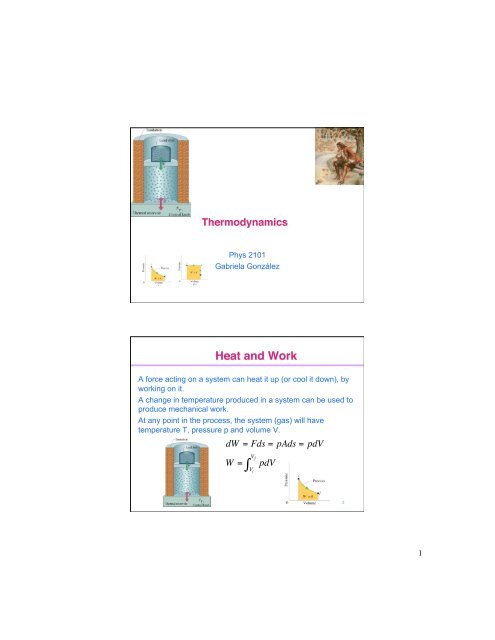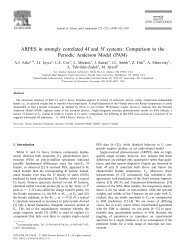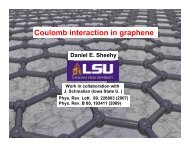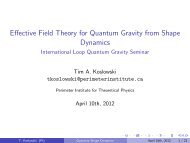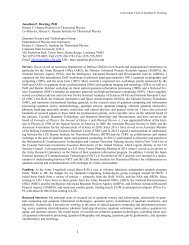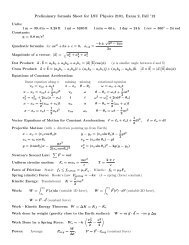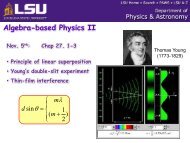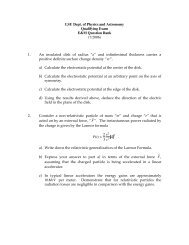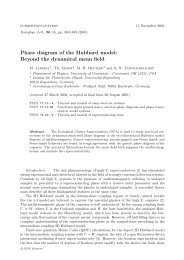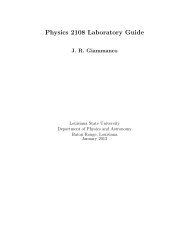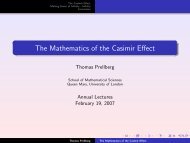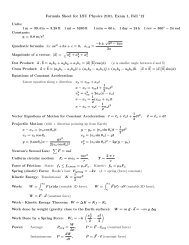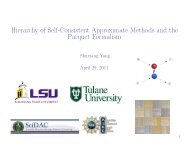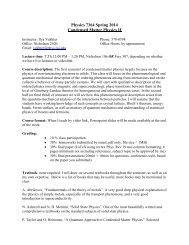dW = Fds = pAds = pdV W = pdV
dW = Fds = pAds = pdV W = pdV
dW = Fds = pAds = pdV W = pdV
Create successful ePaper yourself
Turn your PDF publications into a flip-book with our unique Google optimized e-Paper software.
Phys 2101<br />
Gabriela González<br />
A force acting on a system can heat it up (or cool it down), by<br />
working on it.<br />
A change in temperature produced in a system can be used to<br />
produce mechanical work.<br />
At any point in the process, the system (gas) will have<br />
temperature T, pressure p and volume V.<br />
<strong>dW</strong> = <strong>Fds</strong> = <strong>pAds</strong> = <strong>pdV</strong><br />
∫<br />
V f<br />
W = <strong>pdV</strong><br />
V i<br />
2<br />
1
Changing the system’s pressure and<br />
volume from an initial to a final state<br />
can be done using different amounts<br />
of work (and heat transferred):<br />
W = <strong>pdV</strong><br />
Going back to the original state<br />
does not mean that no work was<br />
done!<br />
The work W done by the system during a transformation from<br />
an initial state to a final state depends on the path taken.<br />
The heat Q absorbed by the system during a transformation<br />
from an initial state to a final state depends on the path taken.<br />
However, the difference Q – W does not depend on the path<br />
taken! We define this quantity as the change in “internal<br />
energy”:<br />
ΔE int= Q – W<br />
The internal energy of a system increases if energy is added<br />
as heat, and decreases if energy is lost as work done by the<br />
system.<br />
∫<br />
V f<br />
V i<br />
3<br />
4<br />
2
The figure shows four possible paths to take a system from an<br />
initial state to a final state. Rank the paths according to:<br />
• the change in internal energy<br />
• the work done by the system<br />
• the magnitude of energy transferred as heat<br />
First Law of thermodynamics: ΔE int= Q – W<br />
Special processes:<br />
1. Adiabatic: Q=0 → ΔE int= – W<br />
� thermally insulated system, or<br />
� very quick process<br />
2. Constant Volume : W=0 → ΔE int = – Q<br />
3. Cyclical : ΔE int = 0 → Q= W<br />
4. Free expansion: Q = W = 0 → ΔE int = 0<br />
� happens in isolated systems, it’s irreversible.<br />
5<br />
6<br />
3
Figure 19-39a shows a cylinder containing gas and closed by a movable<br />
piston. The cylinder is kept submerged in an ice water mixture. The piston<br />
is quickly pushed down from position 1 to position 2 and then held at<br />
position 2 until the gas is again at the temperature of the ice water mixture;<br />
it then is slowly raised back to position 1. The figure shows a p-V diagram<br />
for the process. If 140 g of ice is melted during the cycle, how much work<br />
has been done on the gas? [46600] J<br />
At the microscopic level,<br />
• temperature is a measure of the kinetic energy in the<br />
elemental units (atoms or molecules);<br />
• pressure exerted by a gas is produced by molecular<br />
collisions on the walls of its container;<br />
• the fact that gases fill up the volume of the container they’re<br />
in is due to the freedom of the molecules to move around.<br />
Useful unit for number of atoms: moles<br />
1 mole = number of atoms in a 12g sample of carbon-12<br />
= 6.02 1023 (Avogadro’s number)<br />
number of moles = total number of molecules / NA = total mass / mass of one mole<br />
= total mass /(molecular mass x NA )<br />
7<br />
8<br />
4
Lorenzo Romano Amedeo Carlo Avogadro,<br />
conte di Quaregna e di Cerreto (1776 - 1856)<br />
• An Avogadro's number of standard soft drink cans<br />
would cover the surface of the earth to a depth of<br />
over 200 miles.<br />
• If you had Avogadro's number of unpopped popcorn<br />
kernels, and spread them across the United States of<br />
America, the country would be covered in popcorn to a<br />
depth of over 9 miles.<br />
• If we were able to count atoms at the rate of 10 million per<br />
second, it would take about 2 billion years to count the<br />
atoms in one mole.<br />
9<br />
Gold has a molar mass of 197 g/mol.<br />
a) How many moles of gold are in a 2.50g sample of pure<br />
gold?<br />
b) How many atoms are in the sample?<br />
If we were able to count atoms at the rate of 10 million per<br />
second, it would take about 2 billion years to count the<br />
atoms in one mole.<br />
TRUE OR FALSE?<br />
10<br />
5
All gases approach a unique “ideal gas”<br />
at low densities.<br />
An ideal gas obeys the “ideal gas law”<br />
p V = n R T = N k T<br />
p = absolute pressure (Pa)<br />
V = volume (m 3 )<br />
n = number of moles<br />
T = temperature (kelvin)<br />
R = gas constant = 8.31 J/(mole K) = k N A<br />
k = Boltzmann’s constant = 1.38 10 -23 J/K<br />
N = number of molecules<br />
Ludwig Boltzmann<br />
1866- 1906<br />
• Constant temperature:<br />
keep temperature constant, change the volume. The pressure will change,<br />
following: p = nRT/V<br />
How much work is done by the gas?<br />
isotherms<br />
W = nRT ln (Vf /Vi )<br />
• Constant pressure:<br />
keep pressure constant, change the volume.<br />
The temperature will change, following T=pV/nR.<br />
How much work is done by the gas?<br />
W = p ΔV<br />
• Constant volume:<br />
pressure and temperature may change, but no work is done!<br />
W = 0<br />
pV=nRT<br />
∫<br />
V f<br />
W = <strong>pdV</strong><br />
V i<br />
11<br />
12<br />
6
A gas can be taken from the initial state i to the final state f in many different ways,<br />
usually following constant pressure curves, constant volume curves, and<br />
isotherms.<br />
a) If the initial pressure is 1Pa, and the initial<br />
volume is 1m3 , how many moles are there<br />
in the gas?<br />
b) If the final volume is 1.1 m3 B<br />
, what is the<br />
final pressure?<br />
c) What is the path from i to f where the gas does<br />
minimum work?<br />
A<br />
d) What is the temperature at intermediate<br />
points A, B?<br />
e) If the system is taken to the final state through the 310 K isotherm, and then<br />
back to the original state through point B, what is the total heat added to the<br />
system?<br />
We learned the “ideal gas law”: pV = nRT = nKT.<br />
We know that ΔE int = Q - W, and we can calculate the work for a process from the area in the<br />
p-V diagram. Can we calculate ΔE int and Q from p,V and/or T?<br />
The average translational kinetic energy of molecules in a gas is related only to temperature<br />
(not pressure, or volume). The internal energy of a gas is also related just to temperature. For<br />
a monoatomic, ideal gas,<br />
E int = nN A K avg = (3/2) N k T = (3/2) nRT<br />
(The factor 3/2 can be derived from three directions<br />
of motion for each molecule, each with (1/2) kT energy).<br />
Thus, the internal energy of all states<br />
on an isotherm curve have the same<br />
internal energy.<br />
The work done by a gas between two states<br />
on an isotherm must be equal to the heat<br />
absorbed by the gas.<br />
What’s the heat absorbed between<br />
states on different isotherms?<br />
We can calculate it from Q= ΔE int +W now!<br />
13<br />
14<br />
7
We defined heat capacity C and specific heat c (heat capacity per mass) as:<br />
Q = C ΔT = c m ΔT<br />
For water, c = 1cal/g o C = 1 Btu/lb o F = 4187 J/kg K<br />
The molar specific heat is the heat capacity per mole.<br />
However, the amount of heat needed to<br />
raise the temperature of 1 mole by<br />
1 kelvin depends on whether we<br />
perform the operation at constant<br />
pressure or at constant volume:<br />
Q = n C P ΔT or Q = n C V ΔT<br />
In both cases, Q= ΔE int +W:<br />
ΔE int is the same, but W is not!<br />
Consider a process at constant volume, raising the<br />
temperature by ΔT . Q = n C V ΔT<br />
Q= ΔE int + W<br />
W = 0 !<br />
Q = ΔE int = (3/2) nR ΔT = n C V ΔT<br />
→ C V = (3/2)R = 12.5 J/molK<br />
→ E int = n C V T<br />
15<br />
16<br />
8
Consider a process at constant pressure, raising the<br />
temperature by ΔT. Q = n C P ΔT<br />
Q= ΔE int + W<br />
W = p ΔV = n R ΔT<br />
For any process (1, 2, 3 or 4):<br />
pV = n R T<br />
ΔE int = Q – W<br />
E int= (3/2) n R T = n C V T<br />
Also,<br />
C P = C V + R ; C V=(3/2)R<br />
Constant volume (4):<br />
� W=0,<br />
� Q = n C V ΔT<br />
� ΔE int = n C V ΔT<br />
Constant pressure (1):<br />
� W= p ΔV = nRΔT<br />
� Q = n C P ΔT<br />
� ΔE int = n C V ΔT<br />
Constant temperature (2):<br />
� W = nRT ln (V f /V i ),<br />
� ΔE int = 0<br />
� Q = W = nRT ln (V f /V i )<br />
ΔE int = (3/2) nR ΔT<br />
Q = ΔE int + W = (5/2) nR ΔT<br />
→ C P= (5/2)R = C V + R<br />
True for monoatomic<br />
gases, but not for others!?<br />
17<br />
18<br />
9


